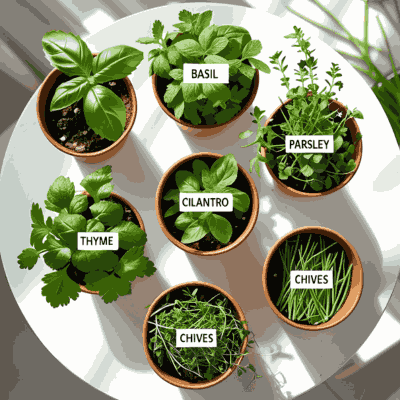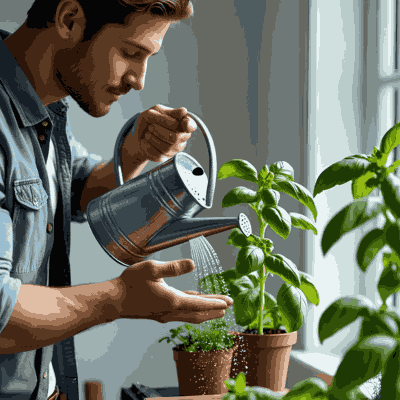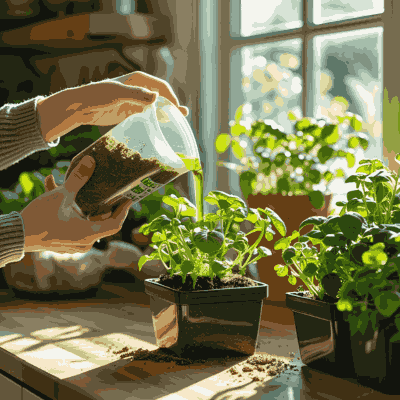Introduction
Want to grow herbs in your apartment, but think space is a problem? Think again! Micro-herb gardens indoors are the perfect solution for anyone with limited space but big gardening dreams. Whether you have a windowsill, countertop, or even just a corner, these compact setups thrive in small environments. This blog gives you 10 expert tips to help your indoor micro-herb garden thrive—even without natural sunlight or a balcony.
1. Best Herbs to Grow in Micro-Herb Gardens Indoors

Start with herbs that are compact, grow fast, and thrive in containers. Popular indoor herbs include basil, chives, cilantro, thyme, parsley, and mint. Choose varieties that match your cooking preferences and light availability.
2. Ideal Containers for Indoor Micro-Herb Gardens
Drainage is crucial for healthy herbs. Use pots with drainage holes and saucers to prevent root rot. Upcycled jars or teacups look great but may need drilling or a layer of pebbles to improve drainage.
3. Finding the Perfect Spot for Your Micro-Herb Garden Indoors

A sunny windowsill is ideal. Herbs love 4–6 hours of sunlight daily. If you lack natural light, consider placing your micro-herb garden indoors under full-spectrum LED grow lights for healthy growth.
4. Choosing the Right Soil for Indoor Herb Plants
Use organic potting soil or a soilless mix designed for indoor herbs. Avoid regular garden soil—it can compact in containers and harbor pests.
5. Smart Watering Tips for Micro-Herb Gardens Indoors

Overwatering is a common issue. Check soil moisture with your finger; water only when the top inch feels dry. Be consistent, but avoid soggy soil conditions that can lead to root rot.
6. Avoid Overcrowding in Indoor Herb Containers
Give each herb its own pot or enough space to breathe. Crowding leads to airflow issues, increasing the risk of disease and stunted growth. Proper spacing keeps your micro-herb garden healthy and vibrant.
7. Pruning Tips for Thriving Indoor Micro-Herb Gardens

Prune your herbs regularly to encourage new shoots and prevent them from flowering too soon. Use clean scissors and never remove more than a third of the plant at once. This boosts productivity and keeps herbs bushy.
8. Managing Humidity for Indoor Herb Garden Success
Indoor air can be dry, especially during winter. Mist your herbs occasionally or place a small tray of water nearby to raise humidity levels. Grouping your plants together also helps maintain moisture in the air.
9. Fertilize Indoor Herbs Lightly and Wisely

Micro-herb gardens indoors don’t need heavy feeding. Use a diluted organic liquid fertilizer once a month to provide essential nutrients without overwhelming the roots. Too much fertilizer can damage delicate indoor herbs.
10. Keep Pests Out of Your Micro-Herb Garden Indoors
Even indoor herbs can attract tiny pests like aphids or spider mites. Combat them naturally with neem oil, insecticidal soap, or by gently rinsing the leaves. Regularly inspect plants to catch issues early.
Final Thoughts
Creating thriving micro-herb gardens indoors is simpler than it seems. With a little planning and care, you can grow fresh herbs year-round—even in small urban spaces. These tips will help your indoor herb garden flourish and fill your kitchen with fresh flavor and green vibes.
Here’s a well-crafted FAQ section (around 250+ words) that you can add at the end of your blog to boost the word count and improve AdSense approval chances:
Frequently Asked Questions About Micro-Herb Gardens Indoors
1. Can I grow herbs indoors without sunlight?
Yes! If you don’t have access to direct sunlight, you can use LED grow lights that mimic natural sunlight. Choose full-spectrum lights and keep them on for 10–12 hours a day to ensure your herbs thrive.
2. What are the easiest herbs to grow indoors for beginners?
Basil, mint, parsley, and chives are some of the easiest herbs to grow indoors. They germinate quickly, don’t require much maintenance, and adapt well to limited space and lighting.
3. How often should I water indoor herbs?
Watering depends on the humidity and light in your space. A good rule of thumb is to water when the top inch of soil feels dry. Overwatering is a common mistake, so check before you water.
4. Do I need to use fertilizer for indoor herbs?
Yes, but in moderation. A diluted organic liquid fertilizer once a month is enough. Avoid overfeeding, as this can burn the roots and harm the plants.
5. How can I prevent pests on indoor herbs?
Keep your micro-herb garden clean and check regularly for pests like aphids or mites. Use neem oil spray or insecticidal soap, and isolate infected plants to prevent spreading.
Happy indoor herb gardening!
